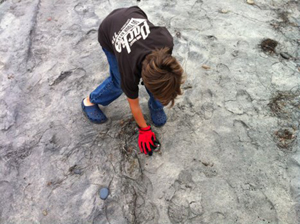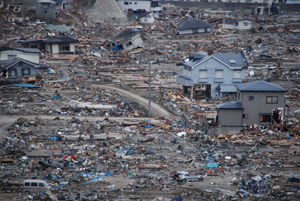Left Column Top
Left Column Bottom
Right Column
Coast 4U Quarterly, Summer 2012
Japanese Tsunami Marine Debris: What We Know and What We're Doing
By Eben Schwartz, Marine Debris Program Manager
California Coastal Commission
I think about this number often of late as I contemplate the amount of debris that is potentially floating across the Pacific as a result of last year's earthquake and resulting tsunami in Japan. That event, which devastated an enormous area of Japan (as much as 220 square miles), resulted in over 15,000 deaths—a massive human tragedy of a scale rarely seen in the world's recent history. A side effect of the tsunami was the release to the Pacific Ocean of some 5 million tons of debris, of which about 1.5 million tons (3 billion pounds) was buoyant enough to float away from the coast of Japan and enter the ocean currents, according to the latest estimates from the Japanese government. What plans are in place for response? Agencies in California and in other West Coast states, along with federal agencies like NOAA and EPA, have been preparing plans to deal with the debris once it starts to arrive on our shores (and as we have seen from the 66-foot long dock that washed up in Oregon recently, it already has). In California, our state Emergency Management Agency is preparing a plan for how to manage the debris if it arrives in such high levels that the event actually rises past the threshold that would constitute a statewide emergency, all the while preparing local emergency management personnel to respond to debris that is suspected to have come from the tsunami. 
The Coastal Commission is working with our Adopt-A-Beach and Coastal Cleanup Day Coordinators to prepare for the influx of volunteers interested in helping clean up the tsunami debris. We are putting in place a monitoring effort so that we can get a firm handle on when large quantities of tsunami debris begins to appear on our beaches. When it does, we want to ensure that interested volunteers are directed to one of our organized cleanups that is being overseen by trained organizers who will be following prescribed protocols concerning monitoring, safety, and notifying the Japanese Consulate in the event that personal effects are found that can be identified. What kind of debris can we expect? The rumors have been flying—that the debris will be radioactive, that there will be human remains washing up. However, these are just that—false rumors, with no basis in fact. Both of these scenarios are extremely unlikely. The tsunami washed the debris out to sea well before the Fukushima Daiichi nuclear plant went into meltdown, so radiation should not be an issue. Similarly, the debris has been out in the ocean for well over a year now, so human remains are extremely unlikely. Nevertheless, to be on the safe side, EPA Region 9 has offered to provide local assistance to some of our beach cleanup efforts to include routine radiation testing of the debris, and emergency management personnel are always available to respond to any situation, such as the discovery of human remains, that would surpass the capabilities of local beach cleanup volunteers. Given the nature of this tragedy, which saw entire villages (and all the associated garbage, plastics, and household items) washed out to sea, it is most likely that the majority of the debris from the tsunami that is buoyant enough to make it across the Pacific and arrive on California's shores will look very much like the debris that our beach cleanup volunteers pick up regularly. Which brings me back to our original numbers. Even if all of the estimated 3 billion pounds of tsunami debris makes it all the way across the Pacific without sinking (highly unlikely), it still pales in comparison to the estimated 18 billion pounds of debris entering the oceans every year. And we can't forget that that latter number comes from a study almost 40 years old - when there were far fewer people on the planet, far less consumption than there is today. There is absolutely nothing we can do to prevent the kinds of natural disasters that hit Japan last year, and nothing to prevent the accidental release of debris to the ocean. There is, however, something we can do about the multiple tsunamis of debris we inflict on the ocean each year through our own carelessness. Our hope and our goal should be to reach a point where the only debris that has a chance to reach our oceans is that which escapes through natural disaster. |

